Media
Morning Train

A tall man in a long coat and a flat cap embraces a woman on a station platform as a train approaches, billowing thick black smoke which frames the couple’s faces. A third figure, perhaps a station attendant, seems to hurry them along. This print’s alternative title, Soldier’s Farewell, confirms the gravity of the scene.
Thomas Hart Benton is known for colorful paintings, energetic prints, and expansive murals depicting historical events. As a prominent participant in the Regionalist movement, he portrayed scenes of rural America in a manner that appears visually stylized yet reflective of everyday reality. Rather than compose Morning Train from solid shapes, the artist created a dense array of thin, curving lines. Even in this melancholy and forboding scene, Benton’s style generates a pervasive sense of motion and liveliness that is common among his works.
Though Benton only shows three figures, do you sense that many other people had similar experiences during World War II? What about this print informs your answer? Which features of the picture help to subtly tell you more about these people and the time and place in which they live?
Asked in 1935 whether the future of American art would lie in the Midwest, Benton responded: “Yes. Because the Middle-West is, as a whole, the least provincial area in America. It is the least affected, that is, by ideas which are dependent on intellectual dogmas.” In the same interview, he went on to describe Midwestern artists as daring risk-takers, independent thinkers, clear communicators, and hard workers. Through his work and his words, Benton was indeed one of the Midwest’s greatest artistic champions. It is no coincidence that his soldier bids farewell not from a crowded dock on the east coast, but from an area of hills, plains, and sparse population—this is the side of American life that Benton found most compelling.
Read MoreMuseumGames: Word Find
Locate the given words in the grid, running in one of eight possible directions horizontally, vertically, or diagonally. There may be an unused word or a message hidden another way to discover related to the puzzle.
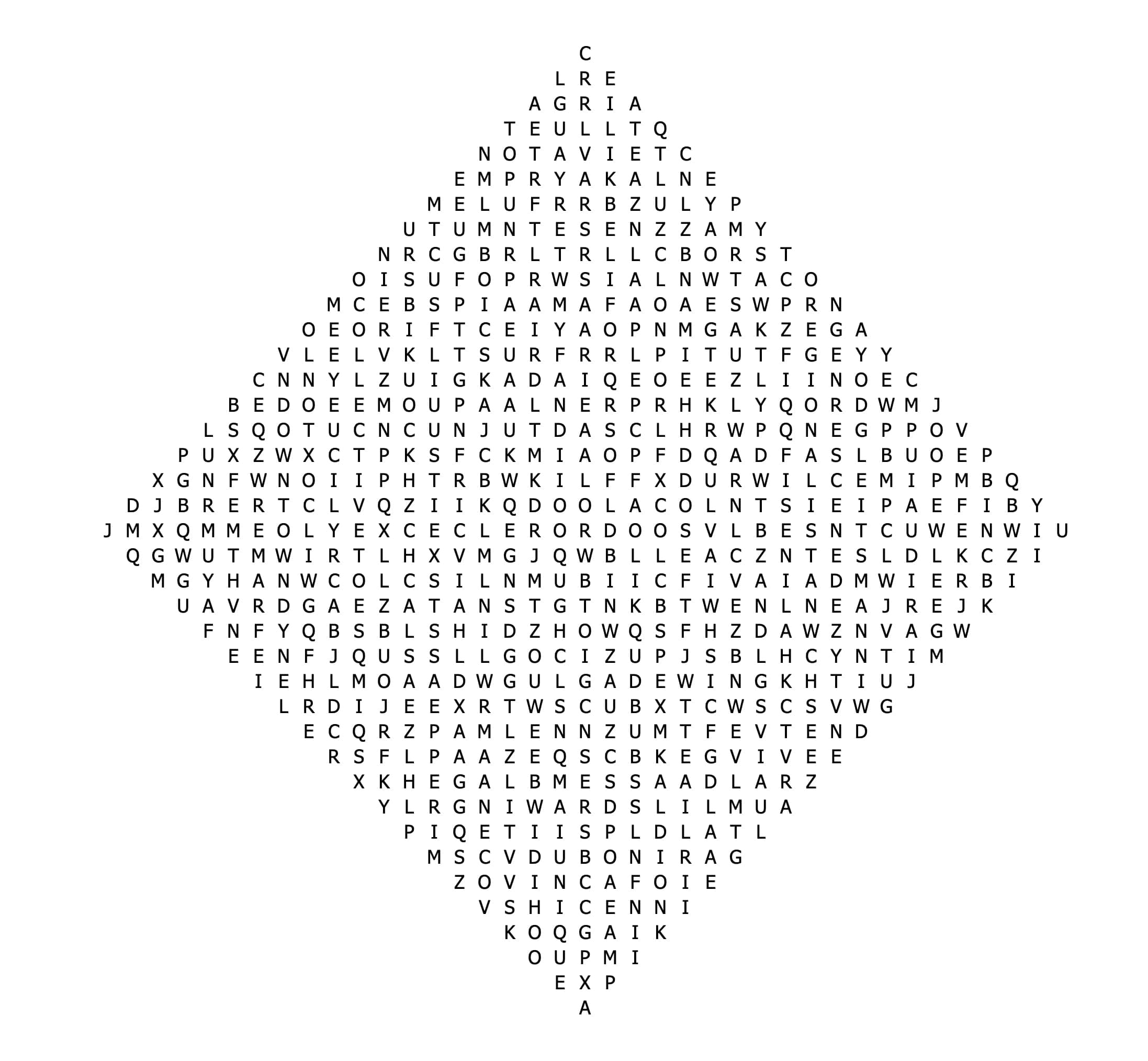
ABSTRACTION
ACRYLIC
ASSEMBLAGE
BIEHLE
CANDID
CANVAS
CIRCULAR
COLLAGE
COLLECTIVE
CREATIVE
CYANOTYPE
DEWING
DOWNTOWN
DRAWING
ELVIS
ENCAUSTIC
FRAME
GALLERY
GENRESCENE
GEOMETRIC
GLASS
GLAZED
GLEITSMANN
LANDSCAPE
LINES
LINOCUT
LITHOGRAPH
LOCAL
MINIATURE
MONOPRINT
MONUMENTAL
MULTIMEDIA
MULTIPLE
MURAL
PANORAMA
PARALLEL
PLEINAIR
PORTRAIT
REALISM
REGIONALIST
RELIEF
SCULPTURE
SILKSCREEN
STILLLIFE
SURF
TEMPERA
UNIQUE
WARHOL
WATERCOLOR
WILCOX
MuseumGames are made possible by PNC with additional support from Acme Fresh Market, the Kathy Moses Salem Philanthropic Fund of the Akron Community Foundation, The R.C. Musson and Katharine M. Musson Charitable Foundation, the Robert O. and Annamae Orr Family Foundation, and the Charles E. and Mabel M. Ritchie Foundation

AAM Mad Libs Art & Ale Edition
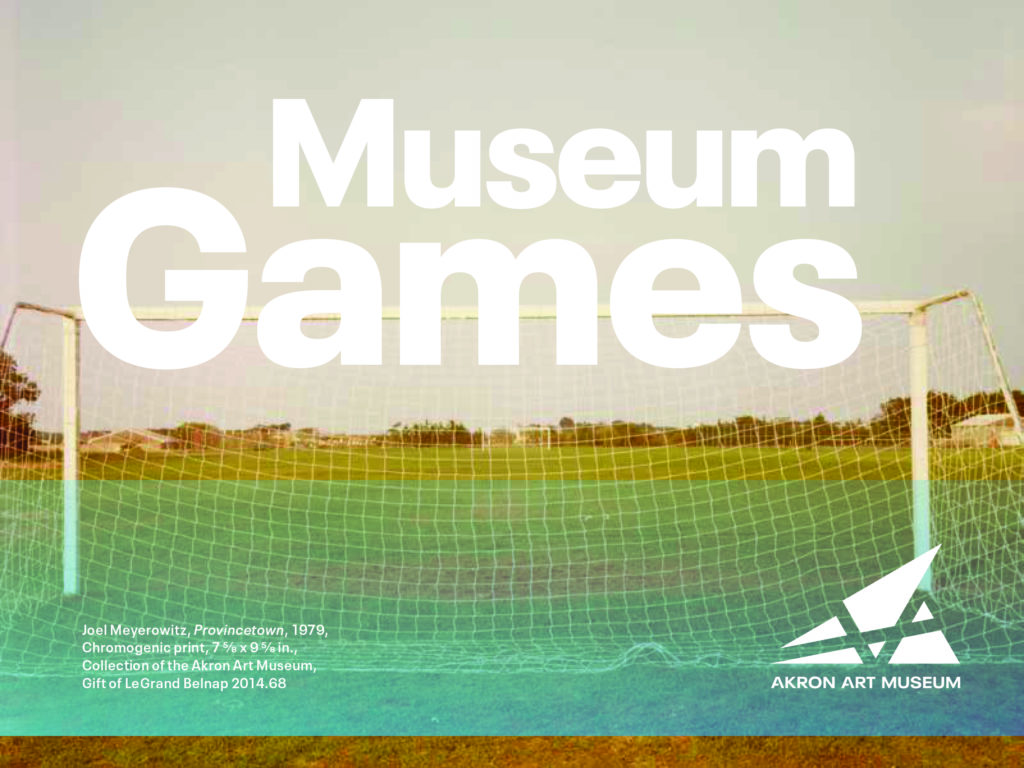
You can play AAM mad libs with your friends or by yourself. Here’s how to play: Creatively fill in the list on the next page with whatever words you like, then transfer your list to the blanks in the story. Finally, read the story from start to finish and enjoy your silly creation! Be sure not to peek at the story until you’ve chosen all of the words to complete it.
Helpful Reminders!
Adjective: Describes things or people
Examples: crazy, short, annoying, messy, fluffy, brave
Noun: Person, place, or thing
Examples: cell phone, spider, home, father
Action Verb: An action
Examples: run, kick, hunt, jump, swim
Verb Ending in “ing”: An action in the present
Examples: running, kicking, hunting, jumping, swimming
Past Tense Action Verb: An action that happened in the past
Examples: ran, kicked, hunted, jumped, swam
Exclamation/Interjection: Expresses a strong emotion
Examples: Oww!, Wow!, Yay!, Yikes!

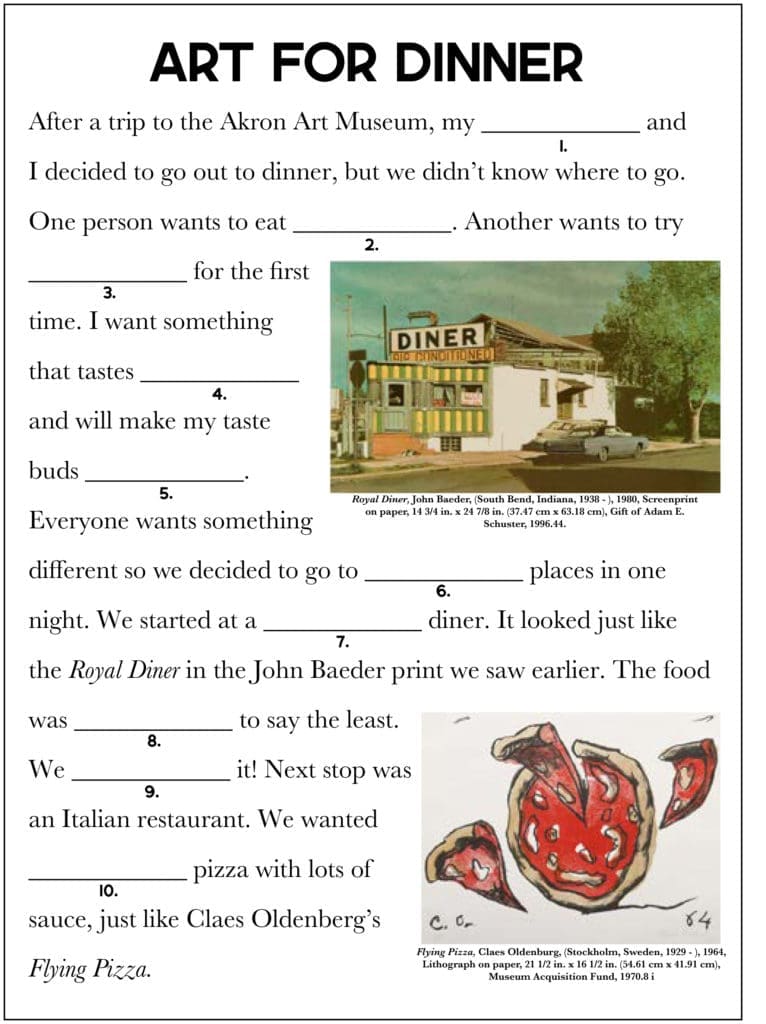

MuseumGames are made possible by PNC with additional support from Acme Fresh Market, the Kathy Moses Salem Philanthropic Fund of the Akron Community Foundation, The R.C. Musson and Katharine M. Musson Charitable Foundation, the Robert O. and Annamae Orr Family Foundation, and the Charles E. and Mabel M. Ritchie Foundation

Market
Leroy W. Flint
In this scene from the Great Depression, a street vendor selling melons, pears, and other fruit contends with a dissatisfied customer. Her outstretched finger implies a request, while his open palms suggest that he cannot be of assistance. Amid economic hardship, perhaps both will go away unsatisfied.
Leroy W. Flint was a guiding force within the Akron art scene. From 1950 to 1965 he taught at the Akron Art Institute (a precursor to the Akron Art Museum), and he served as director for the last nine of those years. Before that, however, he participated in the Works Progress Administration’s Federal Art Project (WPA/FAP), which employed thousands of artists and provided them with economic relief during the Depression. Support from the WPA allowed Flint to complete a variety of murals and prints, including this one, which seems to reflect his experience of the period.
What visual features does Flint use to tell you about the people in this scene—to show their personalities or what they are feeling in the moment that he depicted? Do you think he wanted you to side with either the fruit seller or the customer in their unfolding argument?
A number of artists represented in the Akron Art Museum collection created prints with support from the Cleveland chapter of the WPA. In addition to Flint, these include Frank Daniel Fousek, Kálmán Kubinyi, and Russell T. Limbach. Flint pursued a variety of techniques as a printer, but many of his etchings share the thick, black lines seen in Market. In this particular case he combined the strong contours of etching with aquatint—a similar process, but one that yields smooth tonal gradients rather than precise linework. With this potent combination, Flint was able to render many specific details in his figures’ hands, faces, and clothing, while also adding richness to the scene with a variety of broad gray tones and an application of gritty atmosphere.
Torremolinos, Spain

In this mysterious image, a lone figure draped in a flowing white garment seems to press into the wind as an ocean wave breaks in the background. Her bent pose is unusual and it is unclear why she has her hands clasped behind her head. Is she injured? Is she trying to take off her dress? Stettner’s subjects are often anonymous, so their motivations are not always obvious.
Visually, this photograph appears straightforward, but much of its appeal lies in the details. The dress’s bright highlights echo the white of the cresting wave, balancing out the composition. Stettner also captures slight variations in shading on the water’s surface to create a textured pattern of subtle ripples, echoed in the soft folds of the white dress. The location of this photograph—Torremolinos, Spain—is a slight deviation from the artist’s traditional shooting locales of New York City and Paris. Torremolinos was once a poor fishing town on Spain’s southern coast but experienced a rapid growth in tourism during the 1950s and remains one of the most popular vacation getaways in the region.
What do you think the person in the photograph is doing? What might have happened right before this shot was taken? Or, right after?
Stettner was born and raised in Brooklyn and found much of his inspiration in the people and environment around him. He described his pull to photography saying: “My way of life, my very being is based on images capable of engraving themselves indelibly in our inner soul’s eye.” Often focusing on people and places, Stettner has been praised for his ability to imbue his photographs with a sense of humanity and capture the essence of a personality, a space, or a moment. As a member of the Photo League during the 1940s and 50s, Stettner immersed himself in New York City’s burgeoning photography scene, working alongside noted photographers like Sid Grossman, Paul Strand, and Weegee. After serving as a combat photographer in WWII, Stettner briefly returned to New York and then moved to Paris, where he lived and worked off and on for the remainder of his career. Stettner usually produced works in series, forming collections that explored a single theme such as industrial workers, New York’s Penn Station, or Paris’s city-dwellers. In addition to these series, Stettner also photographed for Life, Time, and Fortune, as well as a number of advertising agencies throughout the U.S. and Europe.
Read MoreAAM Mad Libs

You can play AAM mad libs with your friends or by yourself. Here’s how
to play: Creatively fill in the list on the next page with whatever words you
like, then transfer your list to the blanks in the story. Finally, read the story
from start to finish and enjoy your silly creation! Be sure not to peek at the
story until you’ve chosen all of the words to complete it.
Helpful Reminders!
Adjective: Describes things or people
Examples: crazy, short, annoying, messy, fluffy, brave
Noun: Person, place, or thing
Examples: cell phone, spider, home, father
Action Verb: An action
Examples: run, kick, hunt, jump, swim
Verb Ending in “ing”: An action in the present
Examples: running, kicking, hunting, jumping, swimming
Past Tense Action Verb: An action that happened in the past
Examples: ran, kicked, hunted, jumped, swam
Exclamation/Interjection: Expresses a strong emotion
Examples: Oww!, Wow!, Yay!, Yikes!

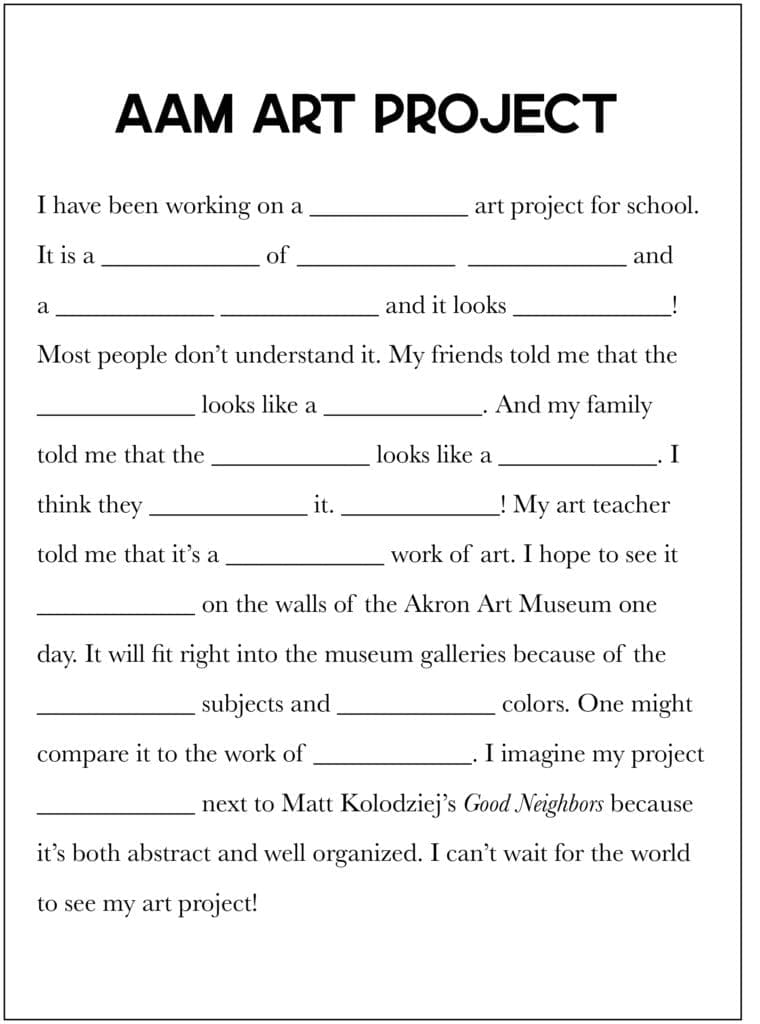
MuseumGames are made possible by PNC with additional support from Acme Fresh Market, the Kathy Moses Salem Philanthropic Fund of the Akron Community Foundation, The R.C. Musson and Katharine M. Musson Charitable Foundation, the Robert O. and Annamae Orr Family Foundation, and the Charles E. and Mabel M. Ritchie Foundation

Studio Interior with Flowers on Bench

Joseph O’Sickey believed “The subject doesn’t matter… what the artist brings to it is the important thing.” While O’Sickey’s still-life and landscape paintings may be conventional in terms of subject matter, he brings to them a joyous celebration of color and life.
In 1968, O’Sickey and his beloved wife Algesa moved to Twin Lakes, OH, just outside of Kent. The home had a lush walled garden which served as inspiration for many of O’Sickey’s works. This lively painting of his studio features a rich interior setting with large windows that look out onto the garden, making it difficult to determine where the indoor studio ends and the exterior garden begins. O’Sickey uses deep purple, bright teal, and fresh green to paint the flowers and plants decorating the tables in his workspace. Just next to them is a delicate blue chair with a mandolin resting against its back. A patterned orange, peach, blue, and purple rug covers the studio floor, adding to the busyness of the scene. O’Sickey employs rapid but assured brushstrokes to render each object, creating a pulsating rhythm that permeates every inch of the canvas.
Do you have a favorite space in your home where you go to work or relax? How is that space decorated? How do you feel when you’re there?
With a career spanning nearly eight decades, O’Sickey left an indelible mark on the arts in Northeast Ohio and was even granted the title “the dean of painting in Northeast Ohio” by Cleveland Plain Dealer arts writer Steven Litt. After displaying an early interest in art as a child, O’Sickey went on to study with renowned Cleveland artists Paul Travis, Carl Gaertner, and Victor Schreckengost at the Cleveland School of Art (now Cleveland Institute of Art). During the 1960s he won multiple “best painting” awards in the May Show, the Cleveland Museum of Art’s annual exhibition of work by Cleveland artists, which ran from 1919-1993. O’Sickey also created a legacy as an influential studio art professor with a 25-year tenure at Kent State University and a brief term at Ohio State University where he met a lifelong friend—Pop artist Roy Lichtenstein. Although O’Sickey managed to secure representation at prominent galleries in New York City, he decided to stay in the Cleveland area, living and working there his entire life.
For further insight on Joseph O’Sickey:
Virtual Family Days: Bookmaking Bonanza
Try your hand at making simple books and book-related objects. This month we have bookmaking tutorials plus some options for turning out artful bookmarks.
Get Art: Why make your own sketchbook?
Before we get to making, we might tackle the big question of the month.
Project 1: Make an Accordion Book
What do you need? Paper
Try this? Fold your paper in even sections. That’s it. This is a simple book to make.
Collection Connection:

Animal Locomotion, Plate 335, 1887. Gift of John Coplans 1979.12 d
Muybridge was a photographer who explore motion by creating a series of compositions from photographs taken in a burst, a bit like the feature on smartphones. Accordion books are a great tool to show a series of scenes. Try making your action packed story with your accordion book.
Project 2: Portfolio stitch
Handbound books can be simple portfolio stitch.
What do you need? Paper, a need, thread
Try this? This project is easy to do.

Collection Connection:

Andy Warhol is best known for his large-scale screenprints, but he worked in many media. Photography and filmmaking were also important tools for Warhol. This small comb bound album houses 20 Polaroids. This instant form of photography is as immediate and exciting now as it was during Warhol’s time. If you have an instant film camera, small handmade books are perfect for albums, as you can custom measure them. If not, consider drawing pictures to fill your album.
Project 3: Make a Bound Sketchbook
An old folder, some paper, a scrap of fabric, and yarn can be turned into a book in a breeze. This PDF offers step by step instructions.
Books can be made simply with tools you have around the house. Fold a few sheets of paper in half. Cut a folder to the same size to serve as the cover. Poke holes with a needle or toothpicks. Sew the book together, starting with the center hole. You might need to watch the video a couple times or refer to the diagram online. After you tie off the yarn, your book is finished. But, gluing on fabric to the cover makes a nice extra touch. After that, your book is done.
What do you need? Paper, yarn or string, a folder, a glue stick, a needle, and fabric
Try this? Once your book is done, you can choose to draw what you want. You can turn the book into a journal of your life, a chance to practice your drawing skills, or a place for your secrets. How will you use your book?
Collection Connection:

Drawing in sketchbooks is an important way aritsts work through ideas. Keeping a sketchbook with you at all times gives you the tools to draw whenever you see something interesting.
Artists, like William Sommer, often draw all the time. Like most things, practice is essential to perfect your craft. Sommer’s drawing shows his own son engaged with a sketchbook.
- If you use your book to draw everyday scenes, what moments would you capture?
- Sommers often used bright and pastel colors. How would you describe his colors and brushstrokes?
- If Sommers is drawing his son, what is his son sketching?
Beautiful Bookmarks
Beauty is it’s own reward, and art doesn’t have to be anything. However, sometimes making useful art feels good.
Bookmarks can be made from simple craft materials. Using a lovely bookmark can make the art of reading feel more special.
What do you need? There are infinite ways to make bookmarks.
- Bubblewrap embroidered with raffia
- Fabric or contact paper corners
- Scraps of file folders decorated with contact paper
- Strips of old artworks
Try this?
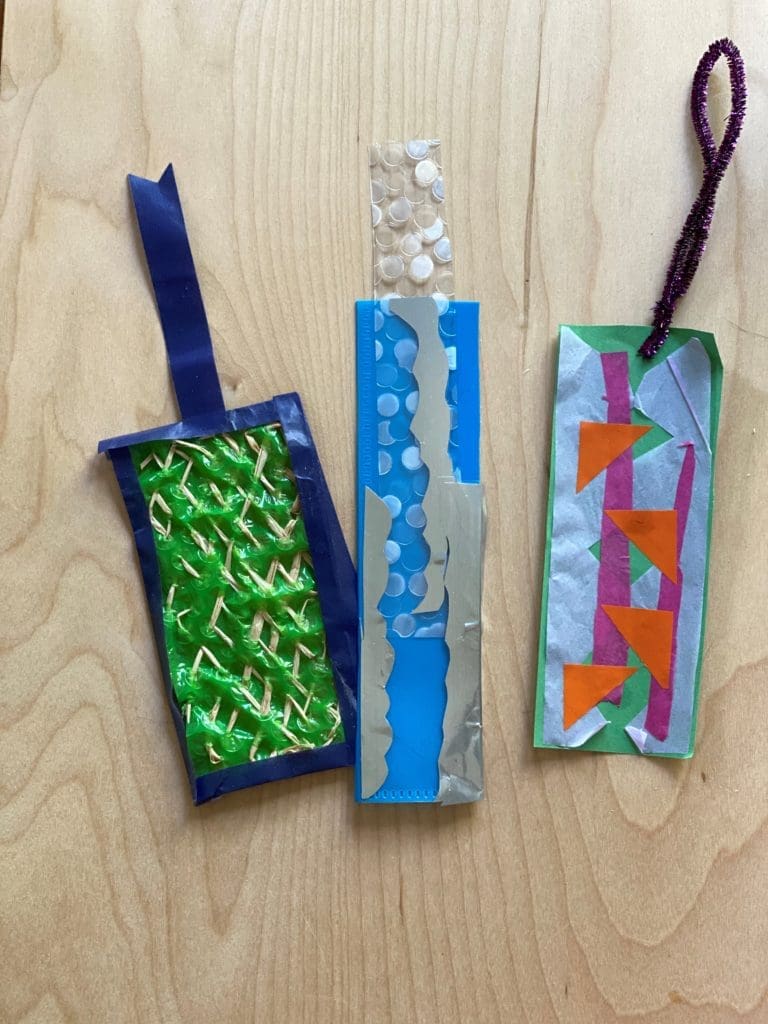
What are other ways you can turn supplies into lovely bookmarks?
Collections Connection:

Sam Gillam’s A Fog in the Hollow, 1974 features layers of color screenprinted onto paper. You can create a similar textured composition with bubble wrap as an easy project. It would also make a wonderful bookmark. Explore last month’s projects for possible sources for bookmark making inspiration.
Make a Zine
Need a quick way to creatively get out your stay-at-home stresses? A new style of sending a message to a friend? A fun approach for adults and kids alike to make a mini-story? Try making a zine!
Zines, short for magazines, are self-published, easy-to-make projects that have zero-to-no stipulations. Zines used to be created as a way for science fiction fans to add onto their favorite narratives, often through cutting and pasting paper together to form a small book or issue. Now, zines can be found as more formal, published material, often produced by a master printer.
What do you need? Using one piece of standard size paper, make an 8-page zine and get started with your own narrative!
8.5×11 inch paper
Scissors
Try This:
Ready?
Hot dog fold
Open up fold
Now, hamburger fold
Open fold, and turn paper
Fold bottom half up to the hamburger fold’s crease
Fold top half to meet bottom half at hamburger fold
Open up folds
(Can you see the 8 pages?)
Turn paper, and hamburger fold, again!
Use scissors to cut along this center crease to the center point
(This cut will allow the paper to fold into a zine)
Open paper
Hot dog fold, but prop it up like a tent
Push the two tent ends into the center
Fold together 3 of the 4 flaps
Take that last flap, and fold into the rest of the flaps
(This is your back cover)
Be sure to crease all the seams well!
Behold- a tiny, baby zine!
Bring out all the goods!
Using stickers, stamps, tape or objects to glue in, can help
to alleviate the pressure to draw or write
Collection Connection:
While the collection doesn’t include zines, we have many works that feature layering of images, a common practice for zine artists. Patrick Nagatani’s The Evening News, Native American Pueblo Dwelling, New Mexico, 1990 is a composition created from many different sources.

Patrick Nagatani (Chicago, 1945 – October 27, 2017, Albuquerque). The Evening News, Native American Pueblo Dwelling, New Mexico, 1990. Gift of George Stephanopoulos 2007.122
Explore the image:
- What are some aspects of the colors you notice?
- Photographers can use tools to make the image seem seamless. Do you see edges around the figures? When artists do this, it reminds the viewer that this scene is not “real.”
- What are some of the parts of the composition? What is in the background? What is in the foreground? Are there any parts of the scene that surprise you?
Try This Invitation: Make a Book about You
With all your bookmaking knowledge, what next? Here’s an invitation to put your book to use.
Collection Connection:
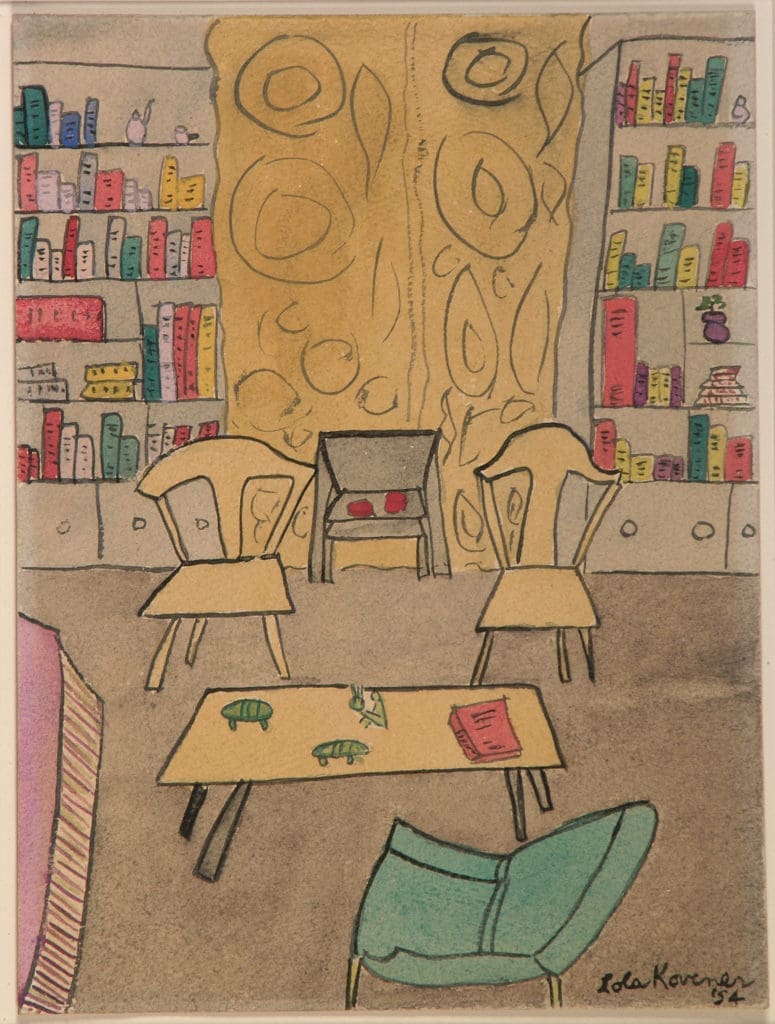
Lola Isroff was a self-trained artist, who liked to sketch buildings and rooms. Here, she shows a cozy living room. Imagine being in this setting. Describe how it would feel to be in this room. Think of your each of your senses as you picture being in the space.
Why make so many different books?
Creativity is a learned skill. Every time to try something new you’re improving your creativity muscles. Explore one artist who could help you think about creativity.
Family Days are made possible by PNC with additional support from The Kathy Moses Salem Philanthropic Fund of the Akron Community Foundation, The R.C. Musson and Katharine M. Musson Charitable Foundation, and the Robert O. and Annamae Orr Family Foundation.

MuseumGames: Word Find
Locate the given words in the grid, running in one of eight possible directions horizontally, vertically, or diagonally. There may be an unused word or a message hidden another way to discover related to the puzzle.
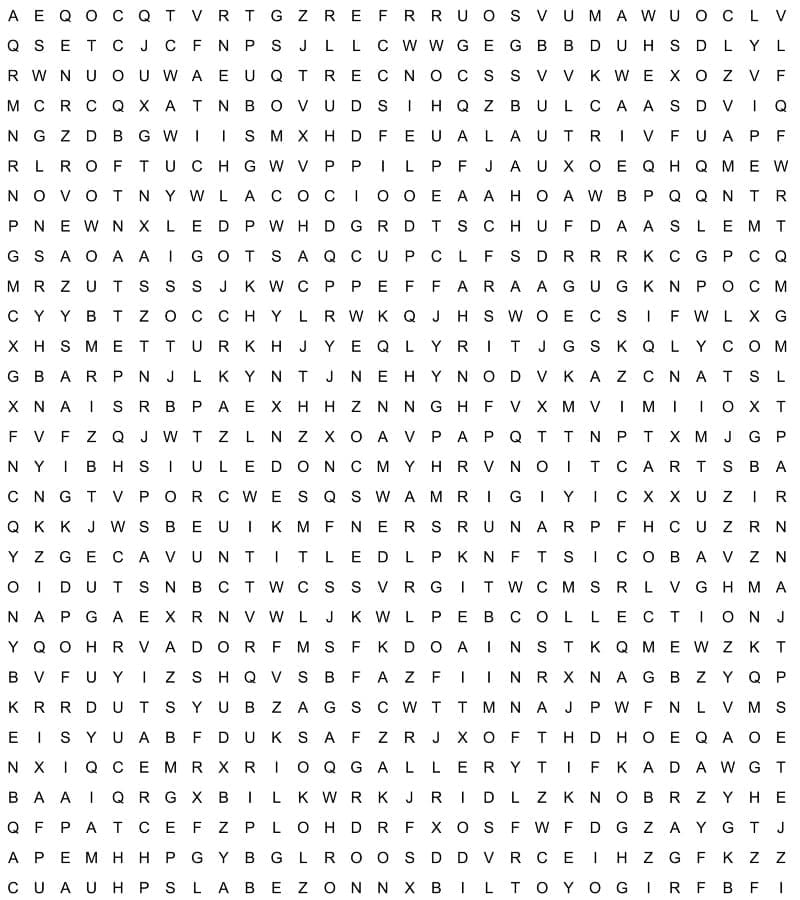
Assemblage
Creative
Podcast
Woodcut
Painting
Sculpture
Screenprint
Studio
Akron
LeWitt
Photograph
Printmaking
Sokol
Studio
Gallery
Gleistman
Stanczak
Novotny
Drawing
Abstract
Thomas
Garden
Untitled
MuseumGames are made possible by PNC with additional support from Acme Fresh Market, the Kathy Moses Salem Philanthropic Fund of the Akron Community Foundation, The R.C. Musson and Katharine M. Musson Charitable Foundation, the Robert O. and Annamae Orr Family Foundation, and the Charles E. and Mabel M. Ritchie Foundation

ARTstrology: Libra
September 23 – October 22

Lovely Libra, you are a master tightrope walker, just like Yinka Shonibare’s dapper gentleman. You create balance everywhere you go, and can find harmony in things that might seem like opposites. But be careful! Libras have a tendency to overthink and take too much advice. Listen to your instincts, and you’ll be able to find your footing just fine.
Libra 23 septiembre – 22 octubre
Linda Libra, eres un maestro de la cuerda floja, justo como este atildado caballero. Creas el equilibrio donde quiera que vayas, y puedes encontrar la harmonía en cosas que parecen ser opuestas. ¡Pero, ten cuidado! Los libras tienden a pensar demasiado y a tomar demasiados consejos. Escucha tus instintos, y podrás encontrar perfectamente tu base.
ARTstrology is made possible with support the Henry V. and Frances W. Christenson Foundation
Read More

